If you haven’t heard about Google Analytics or don’t understand what Google Analytics (GA) is, then this guide is for you!
Maybe you haven’t installed GA on your website, or you have it installed on your website but doesn’t get concerned about checking the data, this guide is also for you.
Considering the rate at which data is generated and used nowadays, it is difficult to believe that anyone wouldn’t have Google Analytics – or any other analytics – installed on his or her website to measure their traffic.
Google Analytics is the most popular web analytics tool for tracking website performance. It’s currently running on more than 10 million websites.
However, in this guide, I will be discussing Google Analytics right from the beginners’ point of view – What Google Analytics is, why you need it on your website, how you can get it installed and use it on your website, etc.
What is Google Analytics?
Google Analytics is a web analytics tool created by Google in November 2005.
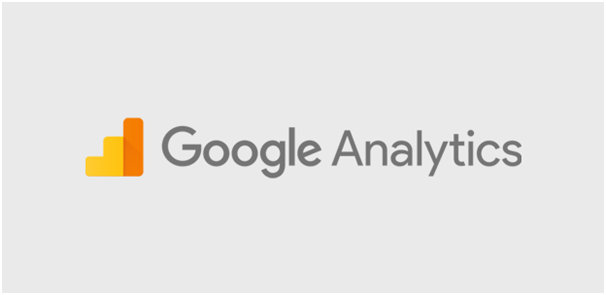
It’s a completely free tool that helps website owners to easily track traffic patterns on their websites, measure and analyze traffic to their website, and gather useful data about visitors to their website.
Aside from helping you to track traffic to your website, this tool can provide vital insights into how your website is presently performing and things you need to do to achieve your goals.
For instance, it’ll help you understand how many visitors your website is getting, where those visitors are coming from, when do they visit, and how these visitors are behaving.
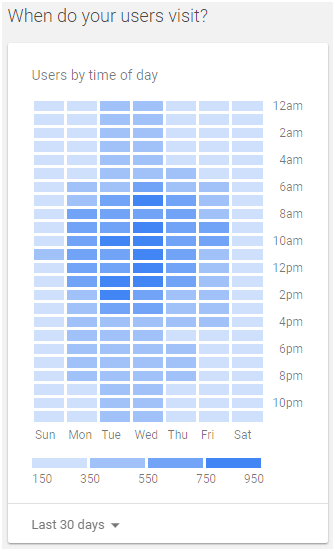
With Google Analytics, you can also monitor the performance of all your social media activities and track traffic from mobile apps. All these will help you to identify the trends and make well-informed business decisions.
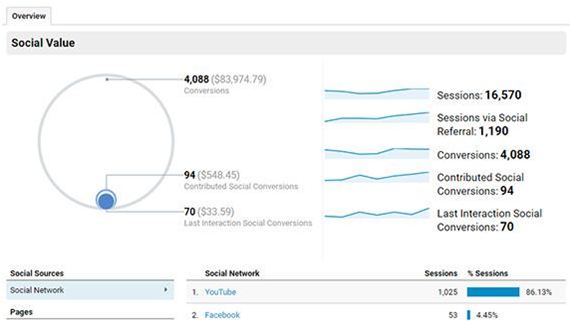
Therefore, Google Analytics is undoubtedly a very powerful web analytics tool for website owners today that gives them the information they need to improve their website and maximize their conversions, making their online marketing campaign generate the desired benefits.
To make this web analytics tool available to everyone across the globe, Google added about 40 languages to this tool.
Though accessing Google Analytics as a complete beginner seems a bit overwhelming, this guide will help you through it and in the end, you would have understood how this extremely useful analytics tool can maximize your website’s performance.
Why You Need Google Analytics?
If you have a blog, a website, or a social media presence, irrespective of whether they are used for business or personal purposes, you need Google Analytics.
Here are a few of the many questions that the tool would answer about your website:
- Do I need a mobile-friendly website or not?
- How can I improve my site’s responsiveness and speed?
- How many people visited my site?
- Where did these visitors come from?
- Where did these visitors go on my website?
- What websites/blogs sent visitors to my website?
- How many of these visitors got converted into leads/customers?
- Which of my blog content attracted the most visitors?
- Which of my webpages is the most popular?
- Which of my marketing campaigns or tactics brought the most traffic to my site?
- Where do my visitors live – location?
- Which pages on my website are the most popular?
Though there are many other questions it can provide answers to, these are some of the most important ones for every website owner.
Now let’s take a quick look at the few basic terms you should know about Google Analytics:
Basic Terms of Google Analytics
Before you go ahead to installing Google Analytics on your website or understanding how it works, you understand the following terms:
Account: This is where each property resides is on your dashboard. You can choose to create a single account, where you would set up multiple properties or you can choose to create different accounts for different properties.
Property: this refers to the mobile application or website that you want to track.
Tracking ID: This is a code attached to your website that enables GA to track it.
Conversion: This is the number of visitors to your website that got converted into customers or prospective customers.
Channel or Traffic source: This tells where your visitors came from. For instance, links from emails, posts on social media, search engines, or other websites.
Session duration: How long a visitor spent on your website.
Bounce rate: The percentage of visitors that viewed just a webpage and leave your website.
Event: The specific activity carried out by the visitor like download a file, watch or stop a video, click on an ad, etc.
Landing page: This refers to the first page your visitors see when they visit your site.
Organic search: This refers to visitors who visit your website from a link on a SERP.
Segment: This is a way to filter data like by types of visitors or by category.
Now that you’ve understood the basics of Google Analytics, let’s go on to installing the tool for your website.
How to Install Google Analytics
Google uses one user’s account for all of its services like Gmail, Google+, Google Doc, Google Drive, YouTube, Google Calendar, etc.
So if you already have a Google account, you can set up your Google Analytics with it, otherwise, you would need to create a new Google Analytics account.
Note that this would be an account that only you should have access — you should plan to keep it indefinitely. However, you may choose to grant anyone else access to your Google Analytics later on but not full control over it.
Therefore, don’t give anyone the login details to your Google Analytics account and do not allow anyone – your SEO service provider, web developer, web designer, etc. – to create a Google Analytics account for your site under their Google account in a bid to easily manage the account for you.
If you and this person no longer work together, your data is gone with him or her and you may have to start the whole process all over again.
Follow the following steps to install Google Analytics on your website:
Set Up Your Account and Property On Your Dashboard
I will assume you already have a Google account. Visit the Google Analytics website and click on “Sign in to Analytics.” If you don’t have a Google account already, click on “Start for Free” to set one up.

The Analytics page should pop up as shown below, click on the “Set up for Free” or “Start Measuring” button.
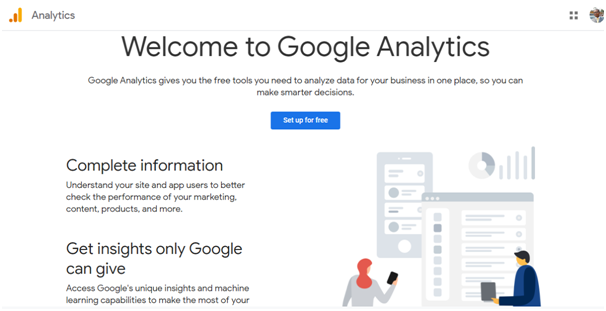
The Analytics dashboard would open to you where you would set up Google Analytics and fill out the information for your website. This contains three sections. The first section is where you input your account name.

Beneath this, there are some options to configure how you want your Google Analytics data to be shared.
And the last section is where you set up the property for whatever you choose in the previous section. Note that Google Analytics makes it possible for you to organize your account in hierarchies.
That means with just one Google account, you can create up to about 100 Google Analytics accounts and each Google Analytics account can hold about 50 properties.
More so, each website property can have about 25 views.
There is no special way to set up your Google Analytics account than to carefully follow the steps and this depends on how you want your website to be organized.
You can also choose to rename or edit your Google Analytics accounts or properties later on.
However, a property can’t be moved from one Google Analytics account to another. Instead, a new property can only be set up under the new account. Note that the historical data from the initial property would be lost once it has been recreated in the new account.
For the purpose of this beginner’s guide, I will assume that you are setting up the Google Analytics account for one website and only need one property. The setup looks like this.
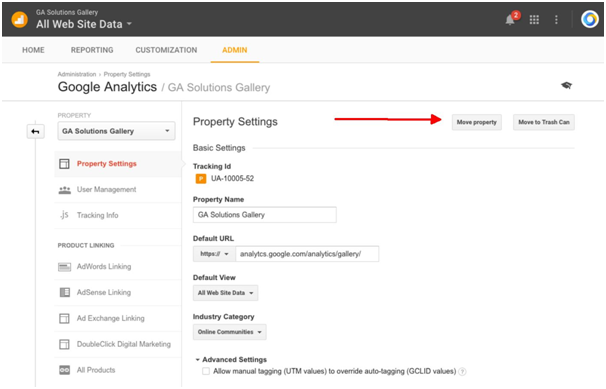
Once you have entered the necessary information and chosen the applicable options, click on the “Create” button. The “Google Analytics Terms of Service Agreement” form will pop up. Click on “I Accept” to accept the terms and move to the next stage.
Installing Your Tracking Code
On the next page, your Google Analytics tracking code will be presented. You need to install this tracking code on your website – paste the code as the first item into the <HEAD> of every web page you wish to track.
![]()
Note that you may need the service of a web developer here in case you can’t do it by yourself.
Although the installation depends on the type of website you have. For instance, some WordPress themes like the Genesis Framework specify an area where you can easily add header and footer scripts to your website.
There is also the Google Analytics by Yoast plugin for WordPress sites that enables you to easily install the Google Analytics code irrespective of the framework or theme you are using.
If you manage a Shopify eCommerce store, you can easily paste the code where specified on your Online Store settings.
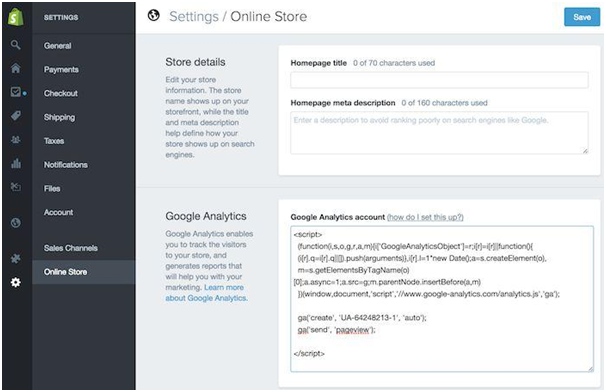
If you manage a blog on Tumblr, simply click on “Edit Theme” on your blog and enter the Google Analytics tracking code.

If your site is built with HTML files, simply add this code before the </head> tag on each page. You can edit the HTML files using any text editor program.
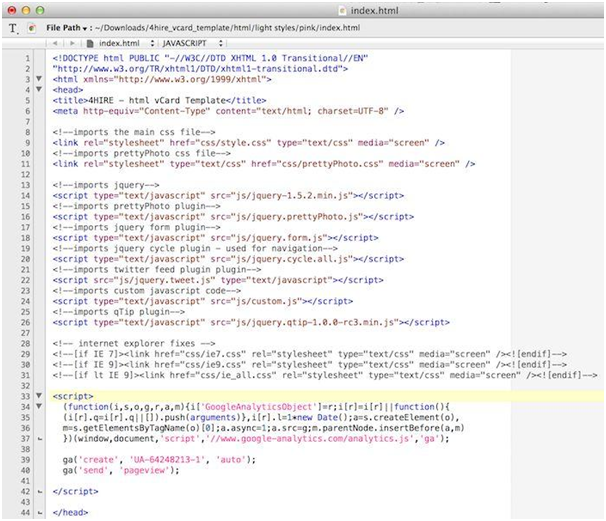
That means, the mode of installation of the tracking code on your website varies depending on the platform your website is, the theme you use on your website, and the plugins you install.
However, you should find instructions on how to install Google Analytics ID on your website platform when you do a simple web search.
Setting Up Your Goals
After you have installed your Google Analytics tracking code on your site, the next step is setting up your goal. This is a small but useful configuration in your site’s profile on the Google Analytics dashboard.
Click on the “Admin” button beside the “User” button on top of your dashboard to launch the admin tab.

And then click on Goals under your “View” “All Web Site Data” column.
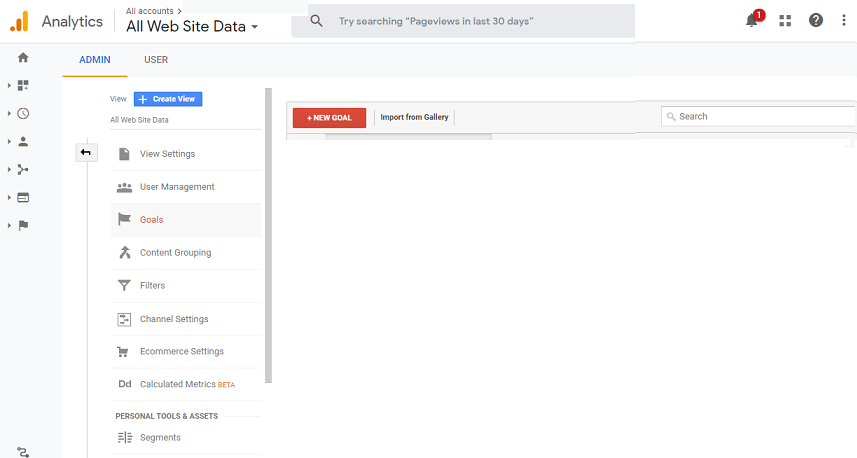
The goals you specify will inform Google Analytics whenever an important action occurs on your site.
For instance, if you have a contact form installed on your site to generate leads, you may want to create or find a thank-you page where your visitors would up after filling the contact form.
Or, if you own an eCommerce store where you sell products, you may want to create or find a final confirmation or thank you page where your visitors would up after completing a purchase. The final page has a URL that looks like this:
- https://yourwebsite.com/thank-you,
- https:// yourwebsite.com/thank-you/, or
- https:// yourwebsite.com/thank-you.html
In the dashboard, click on the “+New Goal” button in red background. A new page will appear. In the first section “Goal setup,” you can choose either the Template or the Custom option.
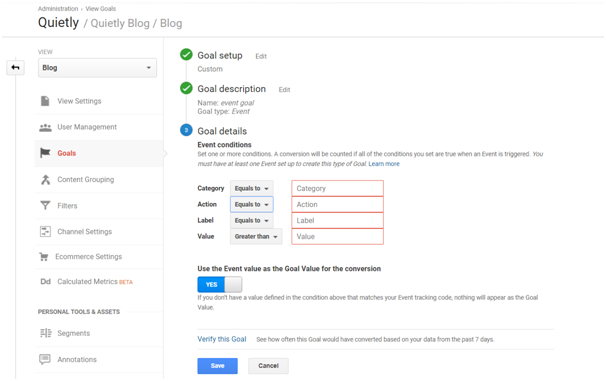
Choose the Template option if some sub-options are more applicable to your site. Click on “Continue” to move to the “Goal description” section.

Here you would give a name to your goal, select a goal slot ID, and select “Destination.” Click on “Continue” to move to the Goal detail section.
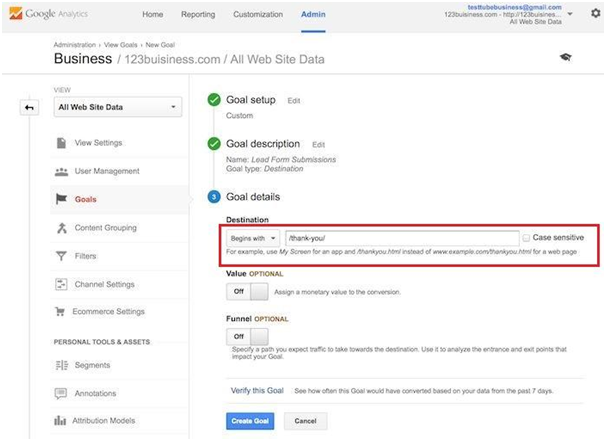
Here, you will have to change the drop-down under the “Destination” field to “Begins with” and type in the URL of your confirmation or thank you page after the .com of your site’s URL.
Toggle the “Value” field to on and enter your exact dollar value for that conversion (this is optional). Click on “Save” to complete the Goals setup.
You can add about 20 goals or conversions on your website to track. So if you have other goals or conversions, simply follow the steps above to create them.
Ensure to create goals that are very important to your business, such as purchase completions, email list signups, lead form submissions, or any other goal applicable to your website’s purpose.
Setting Up Your Website Search
Your website search gives you valuable data about your website and can be quickly set up.
However, this setting is only applicable if your website has a search box on it just like the search box found to the top right of the Moz Blog.
![]()
To set this up, you would need to first visit your website on a new tab and run a search on it. In this case, I used the Moz Blog and I searched for “SEO.” Keep the tab open because you would be using the URL briefly.
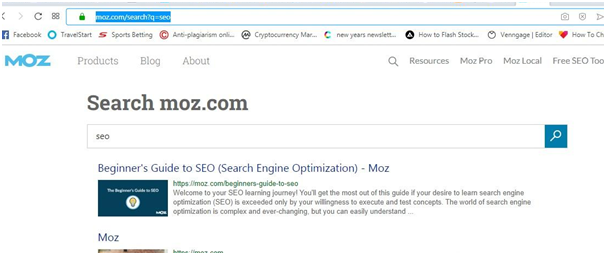
On your Google Analytics dashboard, click on “View Settings.”
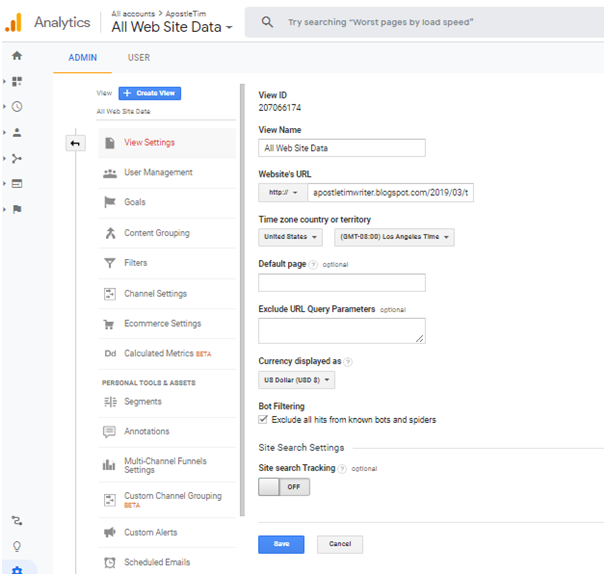
Scroll down to “Site search Tracking” and toggle On. Go back to your website tab and carefully look at the sear result URL.

In this case, it is “https://moz.com/search?q=seo.” Look out for the query parameter – it is either q or s but in this case, it is a “q.” enter this into the “Query parameter” box.

This will enable easy tracking of any search carried out on your website. With this, you would be able to learn more about what visitors are searching for on your web pages.
Adding Additional Accounts and Properties
Practically you have completed setting up your Google Analytics accounts with the step above.
But if you wish to add another Google Analytics account, click on the “Admin” button. Beside the “Account” column, click on the “Create Account” button.
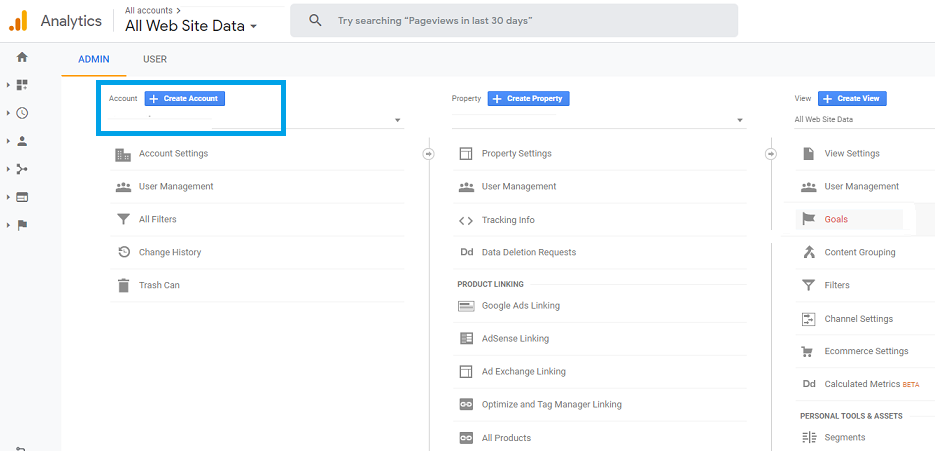
But if you wish to add a new website (property) under the same Google Analytics account, click on the “Create Property” button beside the “Property” column.
Then continue the process by following all the aforementioned steps.
Once you have completed the installation of Google Analytics on your site(s), set up your desired goals, and set up your website search, you would have to wait for about 24 hours for the tool to start gathering your website’s data after which you would be able to view your data.
Viewing Your Google Analytics data
Once your Google Analytics account starts gathering your website data, you can use this data to learn more about the traffic to your website.
Each time you visit your Google Analytics’ page, you would see your website’s Audience Overview report.
But if you have multiple websites added to your Google Analytics account, you would be taken, instead, to a list that contains all of your added websites to choose from.
When you click on a website, you would then be taken to the Audience Overview report for that website you clicked on.
Click on the “Reporting” tab on the top of the page and more than 50 reports about your website would be made available to you in Google Analytics data.
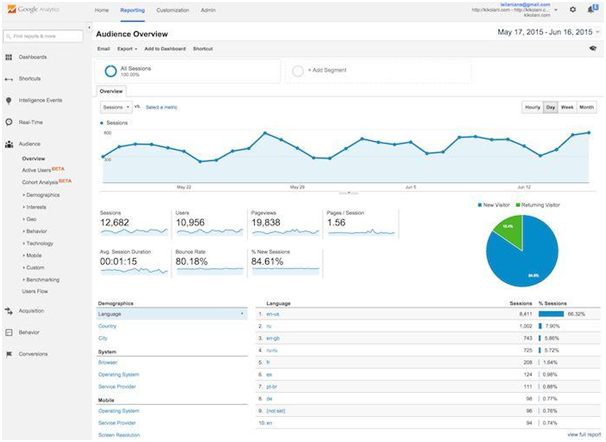
If you wonder how Google Analytics can be useful to your business, consider this case of Lenovo. Lenovo, being one of the top global computer manufacturers, was striving to gain an accurate and complete overview of its marketing efficacy.
The company adopted a data-driven approach using Google Analytics, which helped the company to ensure that attributed figures revealed the actual sales figures.
The company also discovered many other valuable insights that helped it grow.
AccuWeather, the popular and biggest weather media company in the world had been in the digital space for some time and wanted a broader picture of how the digital space impacted its products and channels.
The company adopted Google Analytics to track its web use, app use, down to the email open rates. The Analytics report helped the company to discover an 80 percent open rate for its email service.
Conclusion
There you have it, the complete beginner’s guide to mastering Google Analytics and using it to track your website’s performance. There are both basic and advanced features in Google Analytics that can drive organic search and PPC decisions.
To run successful online marketing campaigns, make sure you’re digging through your Google Analytics data for insights on what to do, which channels to use, and how much budget to set aside.


